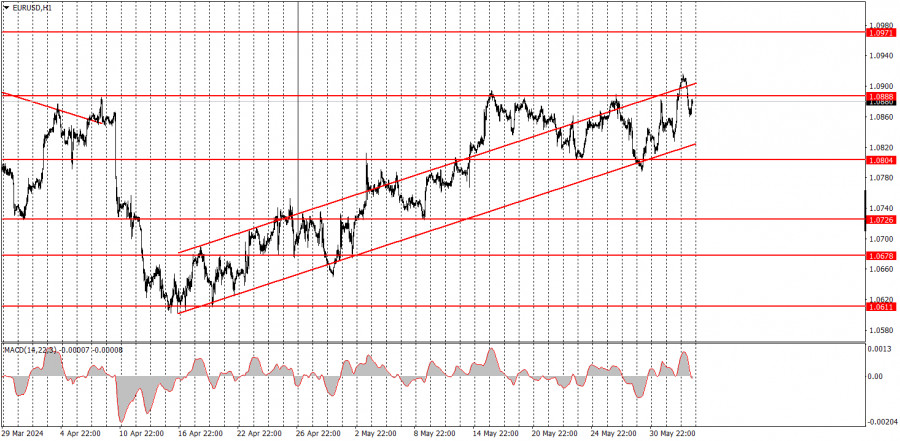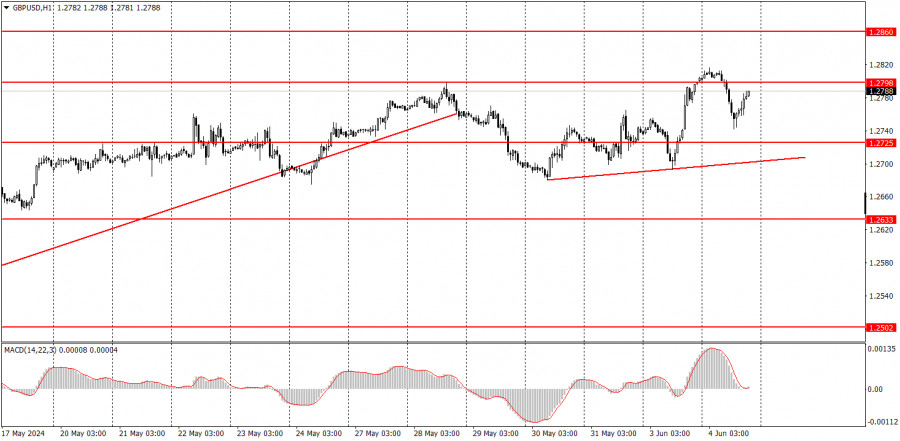Analysis of macroeconomic reports:

There's a full plate of macroeconomic events slated for Wednesday. Of course, the key (or at least the most important) ones will be the data from the US, as has been the case throughout this week. We believe that even the European Central Bank meeting is less important to the market than the reports on the labor market, unemployment, and ISM business activity. Today, the US will release ISM services business activity data for May and the ADP report on changes in private sector employment (this report is analogous to NonFarm Payrolls). The NonFarm Payrolls report is much more important than ADP, but the market can still react to the ADP report. Moreover, both the euro and the pound are currently using any excuse to grow even stronger, so even less important reports unfavorable to the dollar can provoke a significant decline.
The second estimates of the Services PMI data for May will be published in the Eurozone, Germany, and the UK. These reports may only provoke a minor market reaction.
Analysis of fundamental events:

There is nothing to highlight among the fundamental events of Wednesday. The ECB meeting is scheduled for Thursday, so the members of the monetary committee cannot currently comment on potential decisions of the central bank. The Federal Reserve meeting is also approaching, so FOMC members have also entered the "blackout period".
General conclusion:
The main items on today's agenda are the ISM and ADP reports in the US. However, overall, the macroeconomic background will have little significance for the market, which is making a lot of effort to use each opportunity to buy European and British currencies. If the US releases strong reports, the dollar is unlikely to strengthen. If they are weak, it is much more likely for the greenback to fall.
Basic rules of a trading system:
1) Signal strength is determined by the time taken for its formation (either a bounce or level breach). A shorter formation time indicates a stronger signal.
2) If two or more trades around a certain level are initiated based on false signals, subsequent signals from that level should be disregarded.
3) In a flat market, any currency pair can produce multiple false signals or none at all. In any case, the flat trend is not the best condition for trading.
4) Trading activities are confined between the onset of the European session and mid-way through the U.S. session, after which all open trades should be manually closed.
5) On the 30-minute timeframe, trades based on MACD signals are only advisable amidst substantial volatility and an established trend, confirmed either by a trendline or trend channel.
6) If two levels lie closely together (ranging from 5 to 15 pips apart), they should be considered as a support or resistance zone.
How to read charts:
Support and Resistance price levels can serve as targets when buying or selling. You can place Take Profit levels near them.
Red lines represent channels or trend lines, depicting the current market trend and indicating the preferable trading direction.
The MACD(14,22,3) indicator, encompassing both the histogram and signal line, acts as an auxiliary tool and can also be used as a signal source.
Significant speeches and reports (always noted in the news calendar) can profoundly influence the price dynamics. Hence, trading during their release calls for heightened caution. It may be reasonable to exit the market to prevent abrupt price reversals against the prevailing trend.
Beginners should always remember that not every trade will yield profit. Establishing a clear strategy coupled with sound money management is the cornerstone of sustained trading success.
The material has been provided by InstaForex Company - www.instaforex.comfrom Forex analysis review https://ift.tt/zwiyEap
via IFTTT
